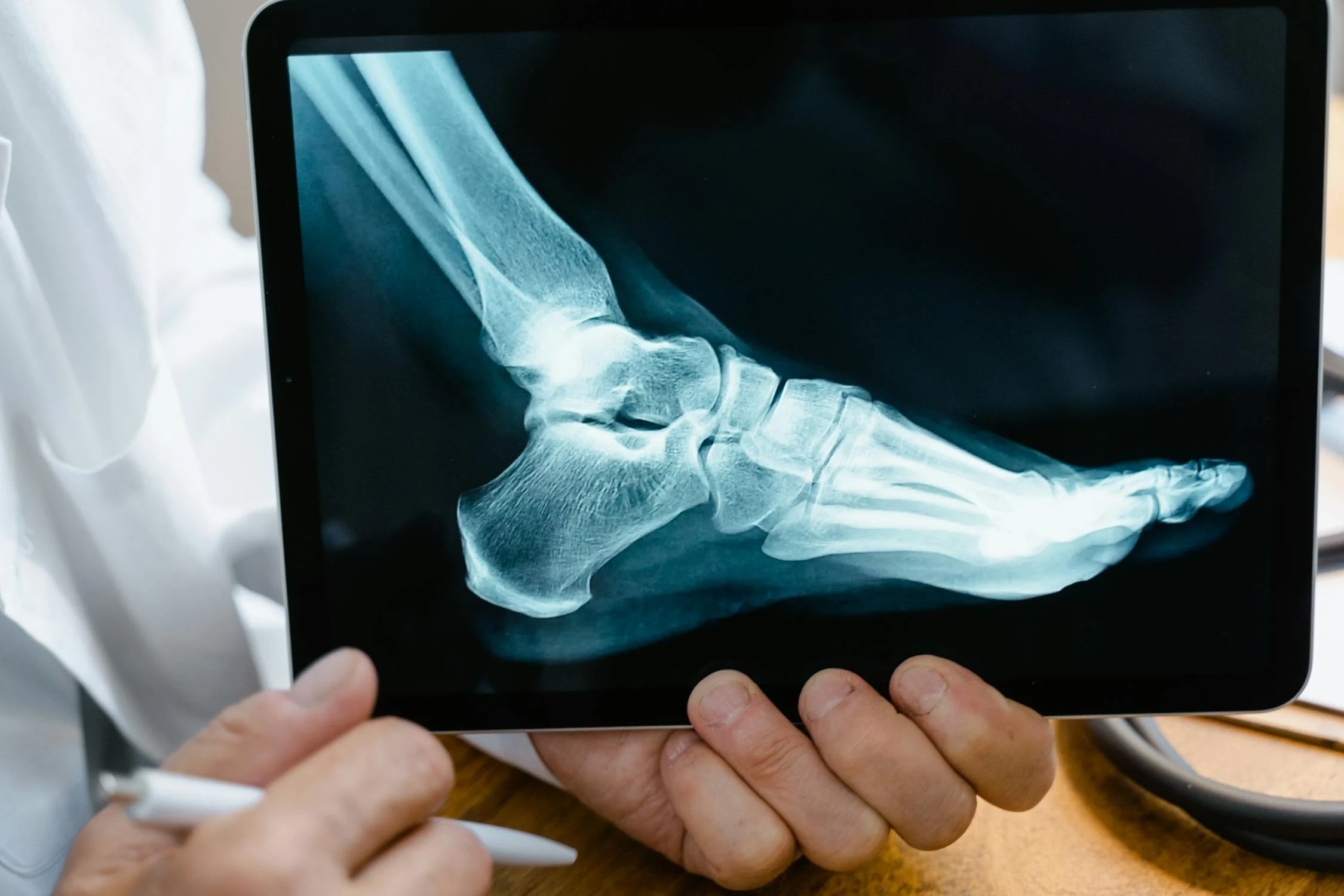Metatarsalgia is a common foot condition that causes pain and inflammation in the ball of the foot. This area, known as the metatarsal region, is where the toes connect to the rest of the foot. For many veterans, metatarsalgia can be a painful reminder of their time in service, especially if they spent long hours on their feet or carried heavy loads.
The pain from metatarsalgia can feel like a burning or aching sensation in the ball of the foot. Some people describe it as feeling like they’re walking on pebbles. This discomfort can make it hard to stand, walk, or do everyday activities. For veterans, this can significantly impact their quality of life after service.
Understanding metatarsalgia is the first step in seeking proper care and compensation through the Department of Veterans Affairs (VA). If you’re a veteran experiencing foot pain, it’s important to know that help is available, and you may be eligible for VA disability benefits.
Causes and Symptoms of Metatarsalgia
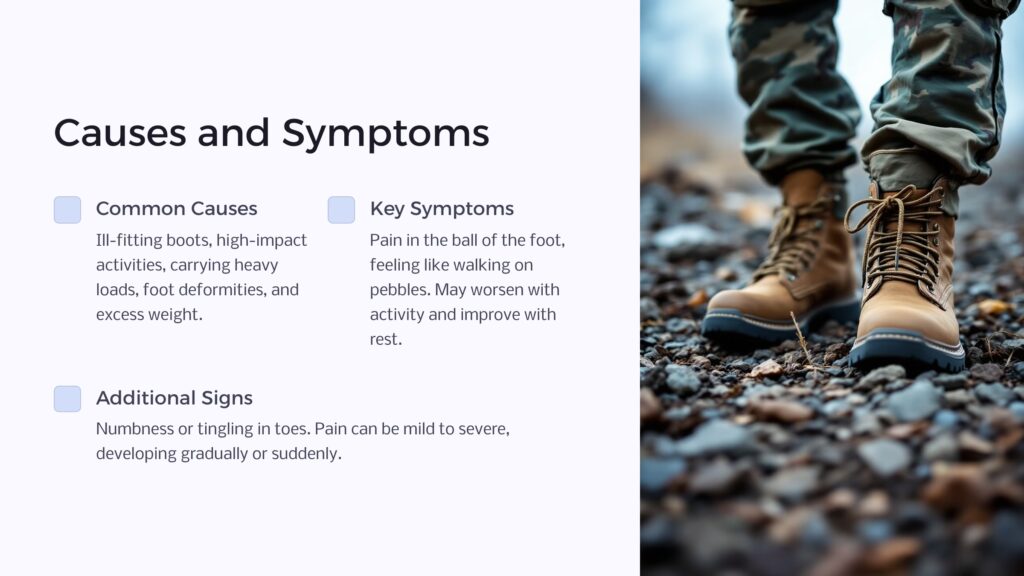
Metatarsalgia can be caused by a variety of factors, many of which are common in military service. These include:
- Wearing ill-fitting shoes or boots for long periods
- High-impact activities like running or marching
- Carrying heavy loads, which puts extra pressure on the feet
- Foot deformities, such as high arches or hammertoes
- Being overweight, which increases stress on the feet
The main symptom of metatarsalgia is pain in the ball of the foot. This pain may:
- Feel sharp, aching, or burning
- Get worse when you stand, walk, or run
- Improve when you rest
- Feel like you’re walking on a pebble or have a bunched-up sock in your shoe
Some veterans may also experience numbness or tingling in their toes. The pain can range from mild to severe and may develop gradually over time or come on suddenly, especially after intense physical activity.
It’s important for veterans to recognize these symptoms and seek medical attention. Early diagnosis and treatment can help prevent the condition from worsening and improve your chances of receiving VA disability benefits.
How Metatarsalgia is Evaluated by the VA
When it comes to evaluating metatarsalgia for VA disability benefits, the process follows specific guidelines. The VA uses a system of diagnostic codes to rate different disabilities, and metatarsalgia falls under code 5279 in the VA’s Schedule for Rating Disabilities.
The VA will consider several factors when evaluating your claim:
- The severity of your symptoms
- How your condition affects your daily life and ability to work
- The medical evidence supporting your diagnosis
- Whether your metatarsalgia is related to your military service
To establish a service connection, you’ll need to show that your metatarsalgia either began during your military service or was caused or worsened by your service. This could include providing evidence of foot injuries during service, or showing how your military duties contributed to the development of metatarsalgia.
The VA may also schedule you for a Compensation and Pension (C&P) exam. During this exam, a healthcare provider will assess your condition and provide an opinion on its severity and connection to your military service. It’s crucial to attend this exam and provide as much information as possible about your symptoms and how they affect your daily life.
Understanding Diagnostic Code 5279
Diagnostic Code 5279 is specifically for anterior metatarsalgia, also known as Morton’s disease. This code is used by the VA to rate the severity of metatarsalgia and determine the appropriate disability compensation.
Under this code, metatarsalgia is rated as 10% for unilateral or bilateral anterior metatarsalgia (Morton’s disease). It’s important to note that 10% is the maximum rating available under this specific diagnostic code. This means that even if your symptoms are severe, you cannot receive a higher rating solely under Code 5279.
However, if your foot condition causes additional impairments or is part of a larger foot disability, you may be eligible for a higher rating under a different diagnostic code. For example, if you have other foot injuries or conditions in addition to metatarsalgia, the VA might consider rating your disability under Code 5284 for “other foot injuries,” which allows for ratings up to 30%.
Understanding this code is crucial when applying for VA disability benefits. It helps you know what to expect and can guide you in providing the right kind of evidence to support your claim.
The 10% Disability Rating Explained
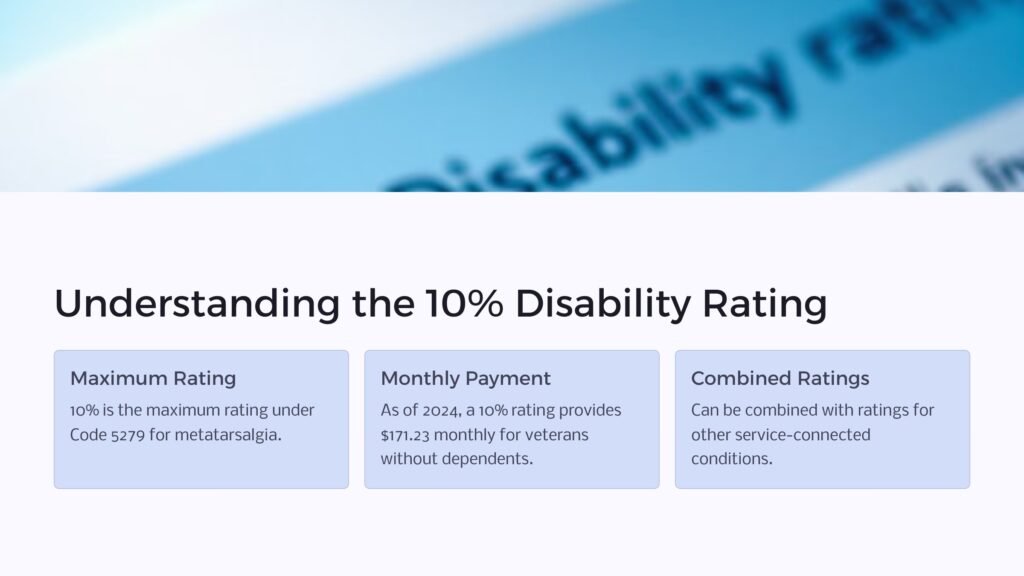
A 10% disability rating for metatarsalgia might seem low, especially if you’re experiencing significant pain and limitations. However, it’s important to understand what this rating means and how it affects your benefits.
A 10% rating acknowledges that your condition causes some impairment in your daily life and work capacity. While it may not fully capture the extent of your pain, it does provide some level of compensation and access to VA healthcare for your condition.
As of 2024, a 10% disability rating provides a monthly payment of $171.23 for veterans without dependents. This amount can increase if you have a spouse, children, or dependent parents. While this may not seem like a lot, it’s a tax-free benefit that can help offset medical expenses or lost wages due to your condition.
Remember, the 10% rating for metatarsalgia can be combined with ratings for other service-connected conditions. This means if you have multiple disabilities, your overall combined rating could be higher, leading to increased compensation.
How to Apply for Metatarsalgia VA Benefits
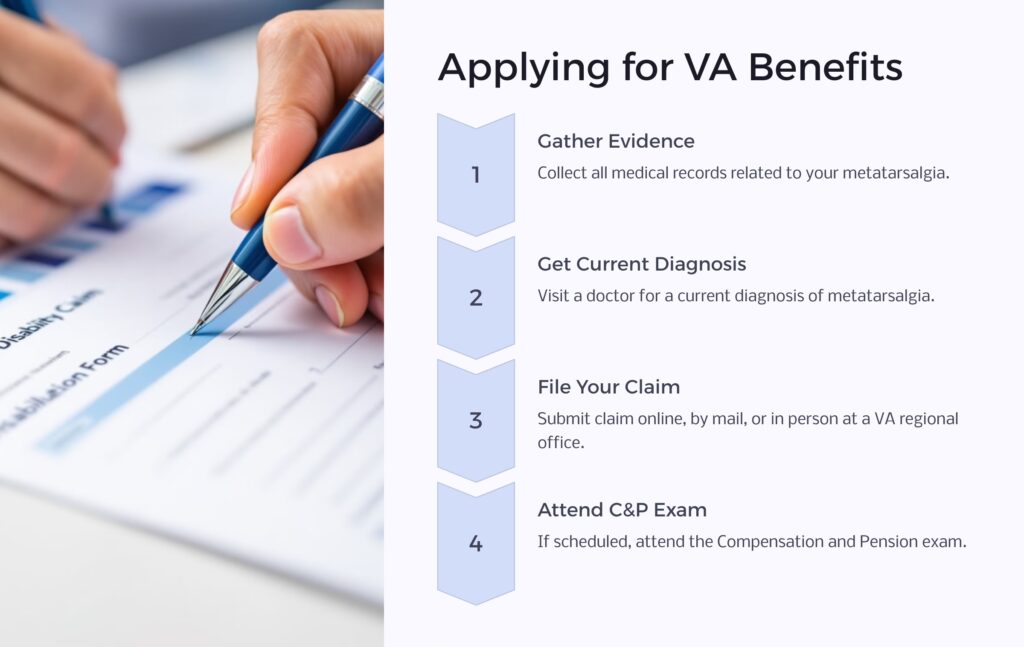
Applying for VA disability benefits for metatarsalgia involves several steps. Here’s a guide to help you through the process:
- Gather Your Evidence: Collect all medical records related to your metatarsalgia, including diagnoses, treatment plans, and any documentation of how it affects your daily life.
- Get a Current Diagnosis: If you haven’t already, visit a doctor to get a current diagnosis of metatarsalgia. This recent medical evidence is crucial for your claim.
- File Your Claim: You can file a claim online through the VA’s eBenefits portal, by mail, or in person at a VA regional office. You’ll need to fill out VA Form 21-526EZ, Application for Disability Compensation and Related Compensation Benefits.
- Provide a Nexus Statement: This is a statement that links your current condition to your military service. It can be from you or, preferably, from a medical professional.
- Attend Your C&P Exam: If the VA schedules you for an exam, make sure to attend. This is your opportunity to have your condition evaluated for rating purposes.
- Wait for a Decision: The VA will review your claim and send you a decision letter. This process can take several months, so be patient.
Remember, the key to a successful claim is providing thorough and clear evidence that your metatarsalgia is service-connected and impacts your daily life. Don’t hesitate to seek help from a Veterans Service Organization (VSO) or a VA-accredited claims agent if you need assistance with your application.
Appealing a VA Rating Decision
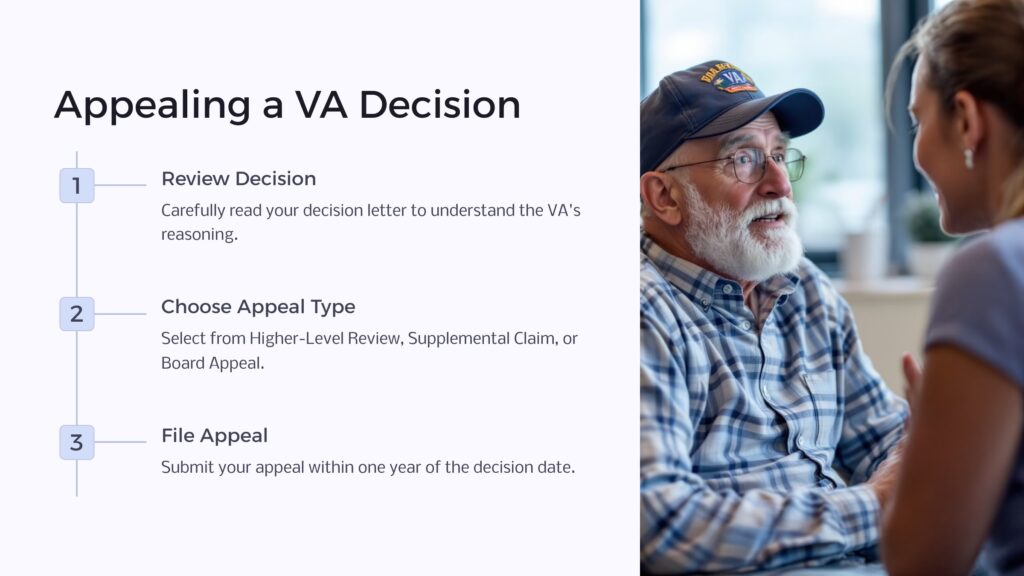
If you receive a decision on your metatarsalgia claim that you disagree with, you have the right to appeal. The appeals process can be complex, but it’s an important option if you believe your condition deserves a higher rating or if your claim was denied.
Here are the steps to appeal a VA decision:
- Review your decision letter carefully. It will explain why the VA made their decision and what evidence they considered.
- Decide which type of appeal to file. As of February 2019, there are three options:
- Higher-Level Review
- Supplemental Claim
- Appeal to the Board of Veterans’ Appeals
- For a Higher-Level Review, you’re asking a senior reviewer to look at your existing claim. You can’t submit new evidence with this option.
- With a Supplemental Claim, you can submit new evidence that you believe will support your case.
- An Appeal to the Board is the most formal option and can take the longest. You can choose whether to have a hearing with a Veterans Law Judge.
- File your appeal within one year of the date on your decision letter to preserve your effective date.
Remember, appealing a VA decision can be a lengthy process, but it can be worth it if you believe you deserve a higher rating. Consider seeking help from a Veterans Service Organization or a VA-accredited attorney to guide you through the appeals process.
Other Foot Conditions Eligible for VA Benefits
While metatarsalgia is a common foot condition among veterans, it’s not the only one that qualifies for VA disability benefits. Understanding other eligible conditions can help you ensure you’re receiving all the benefits you’re entitled to. Here are some other foot conditions that may qualify:
- Flat Feet (Pes Planus): Can be rated up to 50% for bilateral (both feet) cases
- Plantar Fasciitis: Often rated analogous to flat feet
- Heel Spurs: May be rated under the diagnostic code for plantar fasciitis
- Hallux Valgus (Bunions): Can receive a 10% rating per foot
- Hammer Toes: Can receive a 10% rating if all toes are affected
- Claw Foot (Pes Cavus): Can be rated up to 50% for severe bilateral cases
It’s important to note that you can receive ratings for multiple foot conditions, as long as they don’t overlap in symptoms (to avoid “pyramiding” or double-counting symptoms). For example, you might receive separate ratings for metatarsalgia and plantar fasciitis if they affect different areas of your feet.
If you have multiple foot problems, consider discussing them all with your healthcare provider and including them in your VA claim. This comprehensive approach can help ensure you receive the full compensation you deserve for your service-connected foot conditions.
The Role of Medical Evidence in Your Claim
Strong medical evidence is crucial to the success of your VA disability claim for metatarsalgia. This evidence not only proves your diagnosis but also demonstrates how your condition is connected to your military service and impacts your daily life.
Here are key types of medical evidence that can strengthen your claim:
- Service Medical Records: These show any foot problems or injuries you had during service.
- Current Medical Records: Recent diagnoses and treatment plans from your healthcare providers.
- Imaging Results: X-rays or MRIs that show any physical changes in your feet.
- Doctor’s Statements: Letters from your healthcare providers explaining your condition, its severity, and how it relates to your military service.
- Medication Lists: Information about any pain medications or other treatments you’re using for your metatarsalgia.
- Functional Impact Statements: Descriptions from you or your doctor about how metatarsalgia affects your ability to work and perform daily activities.
Remember, quantity isn’t as important as quality when it comes to medical evidence. Focus on obtaining clear, detailed records that directly support your claim. If possible, ask your doctor to use language that aligns with the VA’s rating criteria for foot conditions.
Don’t hesitate to request copies of all your medical records and to ask your healthcare providers for written statements supporting your claim. The more comprehensive and clear your medical evidence is, the stronger your case will be for VA disability benefits.
Tips for Veterans Applying for Disability
Applying for VA disability benefits can be a complex process, but these tips can help make it smoother:
- Start Early: Begin gathering your evidence and preparing your claim as soon as possible after leaving service.
- Be Thorough: Include all relevant information about your metatarsalgia and how it affects your life. Don’t leave anything out, even if it seems minor.
- Keep Copies of Everything: Make copies of all documents you submit to the VA and keep them organized.
- Be Honest: Don’t exaggerate your symptoms, but don’t downplay them either. Be truthful about how your condition impacts you.
- Attend All Scheduled Exams: C&P exams are crucial to your claim. Make sure to attend and be prepared to discuss your condition in detail.
- Consider Getting Help: Veterans Service Organizations (VSOs) offer free help with claims. Consider working with one to navigate the process.
- Follow-up: Don’t be afraid to contact the VA for updates on your claim status.
- Be Patient: The claims process can take time. Stay persistent, but understand that decisions aren’t instant.
- Know Your Rights: Familiarize yourself with the appeals process in case you need to challenge a decision.
- Take Care of Yourself: Continue seeking medical care for your metatarsalgia throughout the claims process. This creates a record of ongoing treatment that can support your claim.
Remember, applying for disability benefits is your right as a veteran. Don’t let the process intimidate you. With preparation and persistence, you can navigate the system and receive the benefits you’ve earned.
Common Misconceptions about VA Ratings
There are several misconceptions about VA disability ratings that can cause confusion for veterans applying for benefits. Let’s clear up some of these misunderstandings:
- “A 10% rating means my condition isn’t serious.” This isn’t true. The rating system is complex, and a 10% rating doesn’t necessarily reflect the full impact of your condition on your life.
- “I can’t work if I receive VA disability.” In most cases, you can work while receiving VA disability benefits. Only veterans with a 100% rating or receiving Total Disability Individual Unemployability (TDIU) have restrictions on employment.
- “My rating will never change.” VA ratings can be increased or decreased based on changes in your condition. You can file for an increase if your condition worsens.
- “I can’t get VA disability if I didn’t see combat.” Combat experience is not required for VA disability. Any condition related to your military service, regardless of how it occurred, may be eligible.
- “I have to be totally disabled to receive benefits.” The VA rating system recognizes various levels of disability, from 0% to 100%. You can receive benefits even if you’re not totally disabled.
Understanding these facts can help you approach the VA claims process with realistic expectations and a clearer understanding of your rights and options as a veteran.
Resources for Veterans with Metatarsalgia
If you’re a veteran dealing with metatarsalgia, numerous resources are available to help you manage your condition and navigate the VA benefits system:
- VA Health Care: Enroll in VA health care to access medical treatment for your foot condition. Visit VA.gov to learn more about eligibility and enrollment.
- Veterans Service Organizations (VSOs): Organizations like Disabled American Veterans (DAV) and Veterans of Foreign Wars (VFW) offer free assistance with VA claims.
- VA Podiatry Services: Many VA medical centers offer specialized foot care. Check with your local VA facility for available services.
- VA’s National Call Center for Homeless Veterans: If your foot condition has impacted your housing situation, call 1-877-4AID-VET for assistance.
- Veterans Crisis Line: For mental health support related to chronic pain or disability, call 1-800-273-8255 and Press 1.
- Local Support Groups: Many communities have support groups for veterans dealing with chronic pain or disabilities.
Remember, you’re not alone in dealing with metatarsalgia. Browse through our library of veteran resources to find the answers you need, take our quiz at Benefits.com to get started towards the benefits you deserve, or contact us for expert guidance and assistance regarding your healthcare options.
 Benefits.com Advisors
Benefits.com Advisors
With expertise spanning local, state, and federal benefit programs, our team is dedicated to guiding individuals towards the perfect program tailored to their unique circumstances.
Rise to the top with Peak Benefits!
Join our Peak Benefits Newsletter for the latest news, resources, and offers on all things government benefits.















